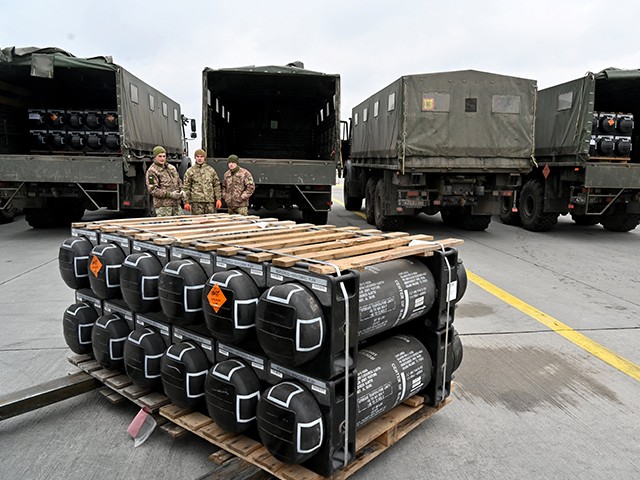Defense contractors are raking in millions of dollars as the Biden administration pledges to continue supporting Ukraine for “as long as it takes.”
The U.S. Army announced in December it awarded an $84 million contract to Raytheon Missiles and Defense for more than 1,000 Excalibur 1B precision munitions to replenish those sent to Ukraine.
Just weeks before, the Army awarded a $432 million contract to Lockheed Martin to replenish High Mobility Artillery Rocket System (HIMARS) launchers that the U.S. and allies sent to Ukraine, according to Defense News. The Army also awarded a $1.2 billion contract to Raytheon for six National Advanced Surface-to-Air Missile System (NASAMS) batteries for Ukraine.
This week, the Biden administration is expected to announce more military assistance to Ukraine when U.S. defense leaders meet with their counterparts in Germany for the eighth meeting of the Ukraine Defense Contact Group.
The U.S. pledged $400 million in military equipment at the group’s last meeting on November 23. CNN reported on Wednesday that the administration is putting together one of its largest aid packages ever.
So far, the U.S. has allocated $113 billion in assistance to Ukraine, which includes $24.2 billion in security assistance since the conflict began in February 2022.
Much of what the U.S. has supplied to Ukraine has come from its military’s own stocks. The Biden administration has dipped into those inventories 29 times, using what is known as “Presidential Drawdown Authority,” or PDA.
But now the flow of weapons is running up against current supplies and the production capacity of the defense industry.
For one thing, the U.S. military needs to keep enough weapons for its own war plans, as well as for its units to continue training and maintaining.
U.S. military and defense officials have “repeatedly” told members of Congress and their staff that they must keep a certain amount of weapons mandated by Pentagon war plans, Foreign Policy reported last month. Those weapons reportedly include Stingers, Javelins, 155 mm artillery, and Guided Multiple Launch Rocket Systems (GMLRS) munitions.
Second, some weapons in high demand in Ukraine had stopped being produced or were being made in only very limited supplies.
For example, Raytheon closed its Stinger production line in December 2020, months before the Russian invasion of Ukraine. In July 2021, the company won a contract to manufacture more but mainly for international governments, according to Reuters.
Raytheon CEO Greg Hayes said during an April 2022 conference call that the Pentagon had not purchased a Stinger in 18 years and that some of the components were no longer commercially available. “So we’re going to have to go out and redesign some of the electronics in the missile of the seeker head. That’s going to take us a little bit of time,” he said, according to the report.
In addition to continuing to supply Ukraine, the U.S. military is trying to backfill what it has already sent, and it will apparently cost the American taxpayer more to keep both endeavors going.

Ukrainian servicemen are at work to receive the delivery of FGM-148 Javelins, American man-portable anti-tank missile provided by US to Ukraine. (Photo by SERGEI SUPINSKY/AFP via Getty Images)
Since defense contractors have been reluctant to ramp up production for a war they are not sure how long will last, U.S. policy makers are trying to incentivize them with non-competitive, multi-year contracts to the tune of millions.
Congress recently authorized multi-year contracts for certain munitions in the recent National Defense Authorization Act.
According to Breaking Defense:
A move towards multi-year contracting is something many in the Pentagon have advocated for, but Congress has historically been shy about granting such authorities. Calls for doing multiyear buying for munitions have become louder in recent months as the war in Ukraine continues to run through munitions supplies for both America and its partners.
The main beneficiaries from the multi-year contracts would be Lockheed, Raytheon, and General Dynamics.
A January 12 Bank of America analysis stated:
Amid the high volatility and headline risks to the FY24 budget process…we continue to believe that General Dynamics (NYSE: GD), Lockheed Martin (NYSE: LMT), and Raytheon Technologies (NYSE: RTX) will benefit from continued presidential drawdowns and USAI funding made to support Ukraine given their large exposure to legacy ground-based systems. These primes have been tasked with both meeting newfound demand throughout Europe and restocking US inventories that have dwindled as a result of the 29 PDAs.
Lockheed’s affiliates and employees donated more than $3.2 million to congressional campaigns and political parties, and more than $10 million on lobbying members of Congress in 2022, according to OpenSecrets.org. Raytheon’s affiliates and employees donated more than $2.2 million and spent more than $8 million on lobbying in 2022, according to the website. General Dynamics’s affiliates and employees donated more than $2.7 million and spent more than $8.4 million on lobbying.
Some inside the DOD have recently expressed worry about where this endless supply of weapons to Ukraine will leave them.
Navy Secretary Carlos del Toro recently told reporters that the U.S. would soon be “challenging” to arm both Ukraine and the U.S. Navy. That came after the U.S. Fleet Forces commander expressed frustration with defense contractors missing weapons delivery targets and wanting to help Ukraine but not in a way that would “destroy and put me back into the dark ages.”
A top defense expert said while weapons shipments do not affect the Navy or a future maritime contingency related to China right now, it could in the future.
Mark Cancian, a retired Marine Corps colonel and senior adviser with the Center for Strategic & International Studies, a think-tank in Washington, D.C., told Breitbart News recently:
For the most part, the shipments to Ukraine do not affect the Navy or deterrence with China. The reason is that the types of weapons and munitions provided to Ukraine are for ground combat, whereas the weapons and munitions needed to defend Taiwan are mostly air and maritime. However, there will be some competition for future production between Taiwan, as it tries to strengthen its armed forces, and the U.S. services as they try to replenish inventories.
He warned in a recent piece that there may be a “crisis brewing” to replace the U.S.’s artillery ammunition.
“The bottom line is that military aid will continue, and Ukraine will still be able to resist, but inventory replenishment will become an increasingly pressing problem. DOD has many tools to mitigate the problem of “empty bins” and will need to use all of them to avoid a slackening of military support to Ukraine,” he wrote.
House Speaker Kevin McCarthy (R-CA) last year vowed to rein in “blank check” spending on Ukraine when Republicans take the majority, but there is support for continuing to supply Ukraine with weapons.
Rep. Joe Wilson, a Republican from South Carolina, recently proposed putting a bust of Ukrainian President Volodymyr Zelensky inside the Capitol.
Follow Breitbart News’s Kristina Wong on Twitter, Truth Social, or on Facebook.

COMMENTS
Please let us know if you're having issues with commenting.